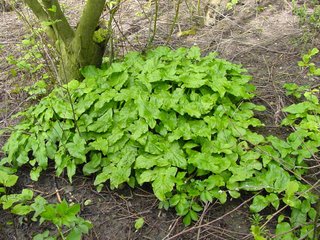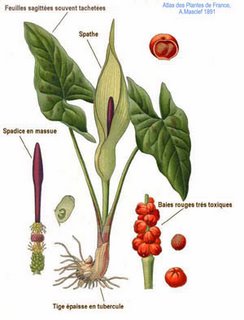Wheyhey, Jackie scoops the prize!!!
Morning all,
I don't know if anyone remembers but about 10 entries ago I asked if anyone knew what this strange flower was that I had noticed in the woods in Arger Fen in Suffolk. No replies for ages until my missus managed to find out what it was. It is called Lords and Ladies and the technical latin names are Arum maculatum, Araceae (Arum family). The dutch name for it "Gevlekte Aronskelk". It is known under several other colloquial names in english for example: Cuckoo pint, Arum, Starchwort, Adder's Root, Bobbins, Friar's Cowl, Kings and Queens, Parson and Clerk, Ramp, Quaker, Wake Robin. This first picture is what it looks like in spring and early summer.
 It flowers: May - June.
It flowers: May - June.Lords and Ladies is a perennial plant of about 25 cm high, which may be patch forming. It has large arrow-head shaped leaves, which are glossy green and have black or purplish blotches. When spring arrives, these leaves may be one of the first to emerge from the ground in shady habitats. The extraordinary 'flower' has a white-green blotched sheath, which form a graciously shaped pitcher-like surround (= a spath) to the purple finger-like spadix. The spadix arises from the real hidden flower below.The spath open in the daytime and actually generates heat, which helps to disperse a faint smell, which is very attractive to insects, but not to the human nose. This is what the flowers look like.
 The flies can go into the hidden chamber (which is designed as an insect ski-slope), but an arrangement of hairs prevents them from flying out again. However this is not meant to be a death trap, but simply a way to ensure that the insects stay for the night to pollinate the flowers. The next day the stamens will mature and shed pollen on the flies This process results in the withering of the hairs and the insects are free once more to fly off to find another similar hotel room for the night.
The flies can go into the hidden chamber (which is designed as an insect ski-slope), but an arrangement of hairs prevents them from flying out again. However this is not meant to be a death trap, but simply a way to ensure that the insects stay for the night to pollinate the flowers. The next day the stamens will mature and shed pollen on the flies This process results in the withering of the hairs and the insects are free once more to fly off to find another similar hotel room for the night. Later on in the year, all that remains of this plant is the pretty fruiting stalk with bright orange-red berries, which is the result of a successfully fertilised flower. These berries are very poisonous to people: "In spite of their very acrid taste, they have sometimes been eaten by children, with most injurious results, being extremely poisonous. One drop of their juice will cause a burning sensation in the mouth and throat for hours. In the case of little children who have died from eating the berries, cramp and convulsions preceded death if no medical aid had been obtained." (Mrs. Grieve)
Later on in the year, all that remains of this plant is the pretty fruiting stalk with bright orange-red berries, which is the result of a successfully fertilised flower. These berries are very poisonous to people: "In spite of their very acrid taste, they have sometimes been eaten by children, with most injurious results, being extremely poisonous. One drop of their juice will cause a burning sensation in the mouth and throat for hours. In the case of little children who have died from eating the berries, cramp and convulsions preceded death if no medical aid had been obtained." (Mrs. Grieve)
Cuckoo pint or Lord and Ladies grows in woodlands, hedges and ditches. It is common in most of Britain, but rarer in Scotland.
Lords and Ladies has a tuberous root, like a small potato. It is brown on the outside and white within. This tuber is acrid like the rest of the plant, but this acridity is lost during drying or cooking and then only the starch is left. Baked tubers can be eaten and are nutritious, because of the starch. Another use of the starch was to stiffen the white ruffs, which were worn round the neck of Elisabethans. The herbalist Gerard comments on this practice:"The most pure and white starch is made of the rootes of the Cuckoo-pint, but most hurtful for the hands of the laundresse that have the handling of it; for it chappeth, blistereth, and maketh the hands rough and rugged and withall smarting." So, No, it wasn't deadly nightshade, but Yes, it is poisonous, well, the berries are. So first prize this week goes to Jackie for solving the mystery.
So, No, it wasn't deadly nightshade, but Yes, it is poisonous, well, the berries are. So first prize this week goes to Jackie for solving the mystery.
Cheerio,
Alan Titchmarsh.

0 Comments:
Post a Comment
<< Home